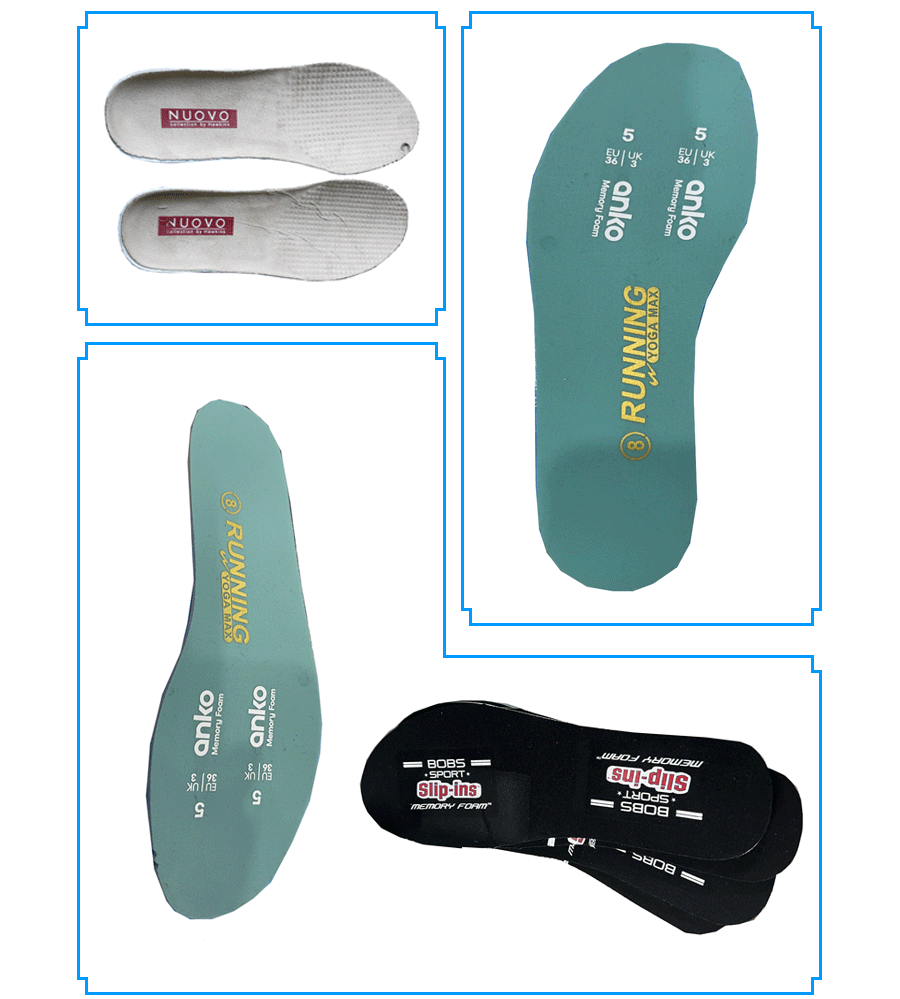The main reasons for silk-screening and then hot-stamping insoles are as follows:
• Improving the pattern effect: Silk-screen printing can accumulate ink thickness through multiple printings, making the pattern more three-dimensional and layered. Hot-stamping is then performed on this basis. The metallic luster of hot-stamping will complement the three-dimensional effect of the silk-screen pattern, making the pattern more vivid and realistic, and achieving a better visual effect.
• Enhancing hot-stamping adhesion: The ink used for silk-screen printing can increase the roughness and viscosity of the insole surface, so that the hot-stamping foil can better adhere to the insole during the hot pressing process, improve the firmness of hot-stamping, and reduce the possibility of hot-stamping layer falling off.
• Compensating for hot-stamping defects: Hot-stamping technology may have limitations in some details and color performance, such as being unable to present overly complex patterns or rich color gradients. Silk screen printing can print these details and colors first, and then perform hot stamping, thus making up for the shortcomings of hot stamping technology and making the patterns and logos on the insoles more complete and rich.
• Improve production efficiency: Silk screen printing first and hot stamping later can complete two processes in one positioning, reducing the transfer and positioning time of the insoles between different processes, improving production efficiency and reducing production costs.
• Protect the hot stamping layer: The ink layer of silk screen printing can protect the hot stamping layer to a certain extent, preventing the hot stamping layer from being scratched, worn and oxidized by external factors, extending the service life of the hot stamping pattern and maintaining its gloss and integrity.
The turntable insole screen printing and hot stamping machine adopts a turntable design, which can realize continuous cycle operation. There are multiple workstations on the turntable, which can place multiple pairs of insoles for screen printing or hot stamping at the same time, reducing the time of loading and unloading. The size and shape of the workbench are usually designed according to the size and shape of the insole, which can provide stable support to ensure that the insole will not move or deform during printing and hot stamping. Some workbenches may also be equipped with adsorption devices to further fix the insole. The screen printing device and hot stamping device are set around the turntable, and the insole is driven by the turntable workbench to enter the screen printing device and hot stamping device in turn, first for screen printing, and then for hot stamping. The screen printing device is a common screen printing machine with screen lifting, and the hot stamping device is a hot stamping machine with automatic up and down hot stamping. The screen printing action and hot stamping action are controlled by the program of the operation panel.
Applicable scenarios
This turntable silk screen printing and hot stamping production line combines a silk screen printing machine and a hot foil stamping machine on a single turntable. It can perform silk screen printing followed by hot stamping on insoles with rough surfaces, textures, and grooves. It is a combined automatic printing production line where the silk screen printer and hot stamping machines each demonstrate their own strengths while compensating for each other's shortcomings. Mainly used in insole manufacturers or related processing factories to perform screen printing and hot stamping on insoles of various materials, such as cloth insoles, leather insoles, rubber insoles, etc. Trademarks, brand names, patterns, patterns, etc. can be printed on the insoles, and the hot stamping process can be used to increase the beauty and added value of the insoles.
Equipment advantages
Compared with traditional silk screen printing and hot stamping processing, this equipment integrates silk screen printing and hot stamping in one, with compact structure, easy operation, high production efficiency, and is an important equipment for shoe industry investment.
Types of Insole label thermal transfer Machine and insole hot foil stamping machine:
Although insoles are a small product, the market is vast. Hot labeling on insoles is a market segment that is being competed for by both hot stamping machines and heat transfer machines. Based on customer needs and the balance between efficiency and cost, various types of insole hot labeling machines have emerged:
Semi-automatic hot labeling machines and insole hot stamping machine: These machines require manual placement and removal of insoles, but can automatically perform some of the hot labeling steps, such as heating and pressurization. These machines utilize high-precision fiber optic positioning, achieving an accuracy of ±0.02 mm and an average production rate of over 1,000 pairs per hour. Semi-automatic hot labeling machines can be configured with either one or two stations. Dual-station hot labeling machines support two people operating simultaneously, doubling efficiency.
Fully automatic hot labeling machines and automatic insole hot stamping machine : These machines feature automatic feeding, automatic cursor positioning, and automatic hot pressing, eliminating the need for excessive manual intervention and significantly improving production efficiency and hot labeling accuracy. Fully automatic hot labeling machines can also print two insoles at a time, utilizing an automatic elevator for feeding, a robotic arm for transfer, and full servo control.











